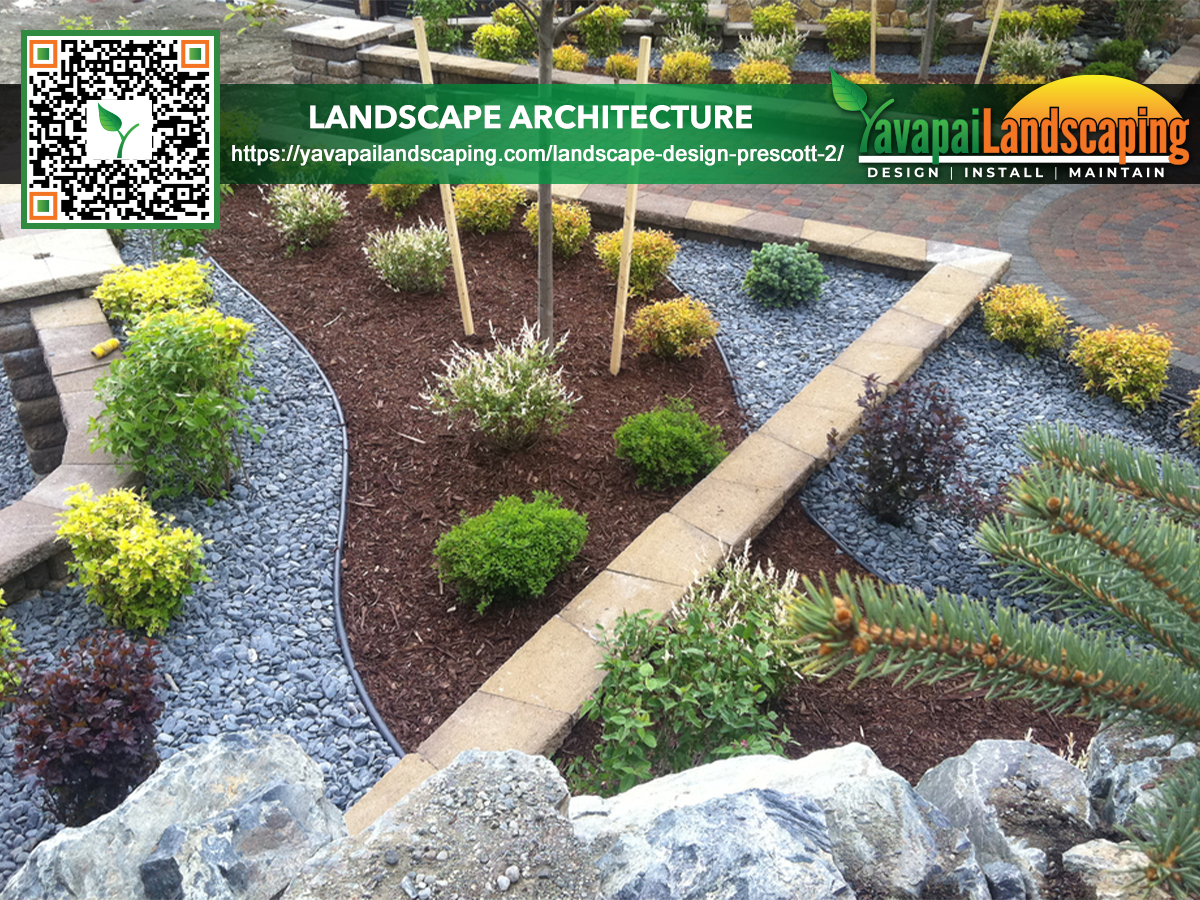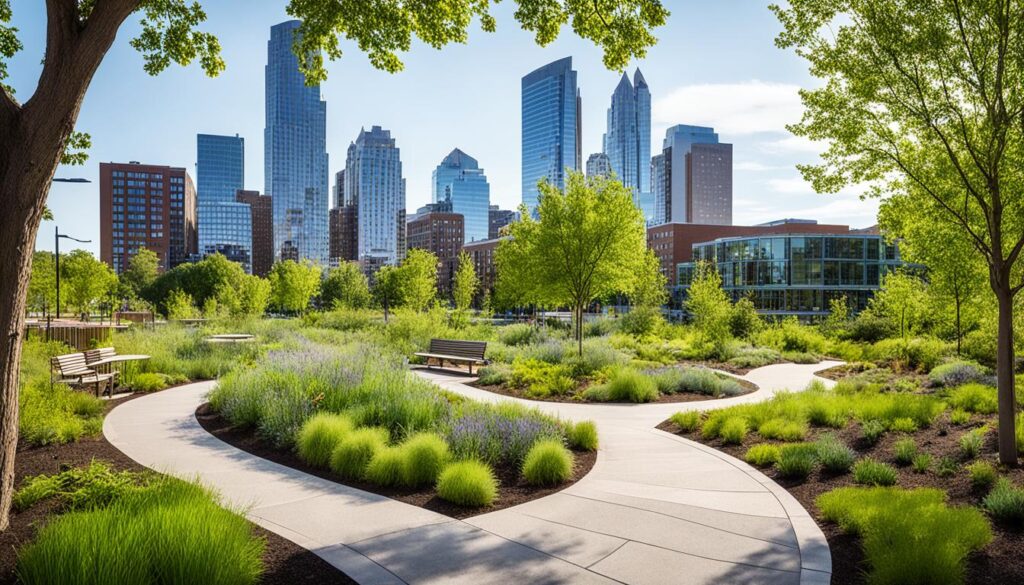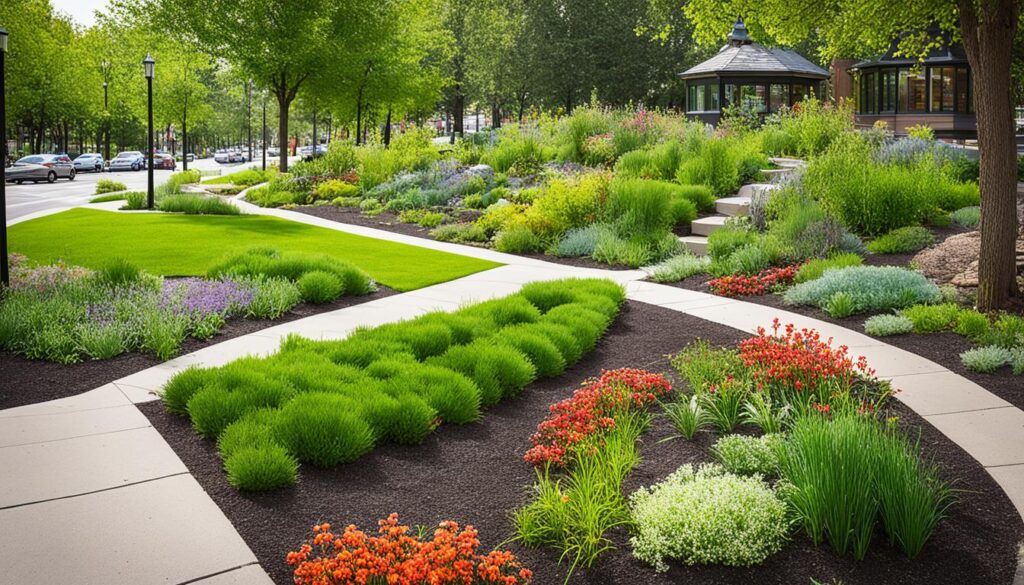
Urban areas are growing fast. That’s why we must use design that’s good for the Earth in architecture. Landscape architecture plays a crucial role in this endeavor. Green infrastructure uses nature to make cities better for people. It improves air quality, fights city heat, and helps plants and animals thrive.
Key Takeaways
- Green infrastructure can improve air quality by filtering pollutants and increasing oxygen levels in urban environments.
- Incorporating green spaces and vegetation can help mitigate the urban heat island effect, providing cooling and regulating temperatures.
- Green infrastructure supports the restoration of natural habitats, promoting biodiversity and wildlife conservation within cities.
- Sustainable landscape design principles can enhance urban areas’ overall aesthetic and livability.
- Investing in green infrastructure can provide long-term environmental and public health benefits.
Enhancing Urban Ecosystems with Sustainable Design
Green infrastructure like parks, gardens, and green roofs is key to better urban areas. It boosts air quality and fights the urban heat island effect. This effect can make cities much hotter than nearby natural areas.
Improving Air Quality
Green infrastructure helps a lot with making the air cleaner. Plants and trees take in nasty stuff like smog and release oxygen. This makes the air healthier for us to breathe. It cuts down on sicknesses like asthma and heart disease. Take a journey of learning with this captivating read.
Mitigating Urban Heat Island Effects
The urban heat island effect makes cities hotter due to lots of concrete and asphalt. These surfaces keep in heat instead of cooling the city. However, green infrastructure brings in coolness through plants and shade.
Parks and green roofs can make cities cooler and use less energy for A/C. This is also better for fighting climate change. It helps cities be more sustainable and ready for hotter weather.
| Benefits of Green Infrastructure | Impact on Urban Ecosystems |
|---|---|
| Improved air quality | Reduction in air pollutants and increased oxygen levels |
| Mitigation of urban heat island effects | Decreased energy consumption for cooling and enhanced climate resilience |
| Promotion of biodiversity | Creation of habitats and support for urban wildlife |
| Stormwater management | Reduced risk of flooding and improved water quality |
Choosing a sustainable design and using green infrastructure greatly helps. It improves the air, cools the city, and helps our cities handle climate change well. Urban planners and architects play a big role in this.

Promoting Biodiversity and Habitat Restoration
Green infrastructure in landscape architecture is key to boosting biodiversity and restoring city habitats. It adds green spaces like urban forests and wetlands to create living areas for plants and animals. These areas are crucial for the survival of many species.
This kind of infrastructure looks good in cities and keeps the environment healthy. It plays a big role in keeping the local ecosystems strong. Many species’ homes are preserved using green infrastructure, and new ones are made. This helps nature thrive in urban areas, offering important ecosystem services.
Preserving and Expanding Urban Habitats
Using green infrastructure helps save and make more space for plants and animals in cities. It connects green areas so wildlife can stay and move around. This way, animals find what they need to live and grow.
- Urban forests and green spaces offer food and shelter for birds, insects, and small mammals.
- Wetlands and rain gardens provide critical habitats for aquatic species, such as amphibians and marine invertebrates.
- Green roofs and vertical gardens can host a variety of pollinator species, including bees and butterflies.
Enhancing Biodiversity and Ecosystem Resilience
Green infrastructure does more than save habitats. It encourages the spread of life in cities. By planting native plants, architects invite more wildlife into urban areas.

With more kinds of plants and animals, cities become stronger. They can deal with hard times better. This makes urban areas more friendly to both people and wildlife.
Furthermore, green infrastructure can also significantly impact the well-being of urban residents. Studies have shown that people who live in areas with more green spaces tend to have lower stress levels, improved mental health, and even longer lifespans. By incorporating native plants and wildlife into urban design, cities can become more sustainable, livable, and healthy for their inhabitants. This is especially important in densely populated urban areas, where the need for green spaces and wildlife habitats is often overlooked. By prioritizing green infrastructure, cities can create a more balanced and harmonious relationship between humans and nature, ultimately leading to a better quality of life for all.
Conclusion
Using green infrastructure in landscapes is a big win for cities today. It helps make urban areas better for everyone. It makes the air cleaner, tackles the city heat, and brings back plants and animals.
Our cities face big problems like too many people, climate change, and earth damage. Green solutions are key to making cities nicer, more adaptable, and eco-friendly. They prepare us for what’s ahead.
Going green in our city designs is really important. It helps cities bounce back from hard times and improves life. This approach makes urban areas healthier and fairer places for people and nature.
Yavapai Landscaping Prescott offers free quotations for landscaping and tree services in Prescott and its nearby localities. These include tree removal, trimming, stump grinding, land clearance, storm cleaning, and emergency tree service.
